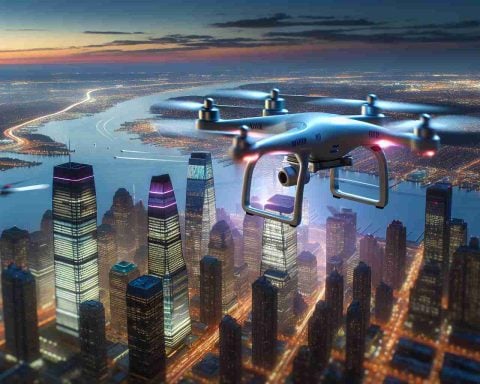The Pilots’ Misidentification Dilemma
On a memorable night in August 2022, five pilots aboard two commercial flights observed bright, unusual lights darting across the Pacific sky. They believed they had witnessed evidence of an Unidentified Anomalous Phenomenon (UAP). In a surprising twist, these captivating lights were determined to be Starlink satellites.
As the popularity of low-Earth orbit satellites grows, so does the confusion surrounding them. Reports have shown that a significant number of sightings, particularly between January and April 2023, were mistakenly classified as UFOs, with many of these being Starlink satellites. This has raised concerns over miscommunication and possible distractions among pilots during flights.
The root of the problem lies in the lack of real-time satellite tracking data accessible to pilots. Without this information, distinguishing these satellites from UAPs becomes a challenge. Starlink satellites orbit around 342 miles above the Earth and are designed to be visible as small bright lights in the night sky.
To tackle this issue, a research team led by Douglas J. Buettner from the University of Utah has developed a modeling technique to accurately pinpoint satellite locations. Their research, which utilized cockpit footage and flight data, illustrated how these satellites could easily be misconstrued under certain lighting conditions.
The possibility of integrating better satellite tracking systems into aviation could significantly reduce safety risks and improve identification protocols. Clear guidelines for both pilots and air traffic controllers, alongside satellite operators sharing crucial data, could pave the way for safer skies.
Are Pilots Ready for the Satellite Era? Understanding the Impact of Starlink on Aviation
The Pilots’ Misidentification Dilemma
In recent years, the proliferation of low-Earth orbit satellites, such as the Starlink constellation, has sparked heightened interest and concern among aviation communities. Notably, an incident in August 2022, where multiple pilots reported seeing unusual lights in the night sky, has unveiled a substantial dilemma: the misidentification of these satellites as Unidentified Aerial Phenomena (UAPs). This misidentification is more than just a fleeting curiosity; it poses serious safety and operational implications for the aviation industry.
# The Rise of Starlink and Misidentifications
Between January and April 2023, a surge in reports detailing sightings of supposed UFOs was noted, with many of these cases ultimately traced back to the Starlink satellites. These satellites, orbiting at approximately 342 miles above Earth, are engineered to be highly visible as they reflect sunlight, leading to confusion among pilots who lack immediate access to real-time satellite tracking data.
# Implications for Aviation Safety
A major concern is the potential for miscommunication and distraction among flight crews caused by these sightings. In an environment where safety is a paramount objective, the inability to distinguish between a satellite and an actual UAP may lead to unnecessary alarm or mismanaged protocols during flight operations.
As Douglas J. Buettner’s research at the University of Utah suggests, the current limitations in pilots’ access to satellite tracking data contribute significantly to this issue. Buettner’s innovative modeling technique, which incorporates cockpit footage and flight data, highlights crucial factors: lighting conditions and satellite trajectories can easily mislead visual identification.
# Solutions for Enhanced Identification
To mitigate the risks associated with the misidentification of satellites, the aviation industry must look towards integrating advanced satellite tracking systems. Here are some innovative suggestions:
– Real-Time Tracking Systems: Implementing live satellite tracking information in aircraft displays could substantially help pilots differentiate between satellites and other aerial phenomena.
– Guidelines and Protocols: Establishing clear identification procedures for both pilots and air traffic controllers is essential. This can involve educational initiatives on recognizing satellite patterns and operational protocols when such lights are observed.
– Data Sharing Agreements: Encouraging satellite operators to share their data with aviation authorities can provide an additional layer of security and information. Increased collaboration between the aerospace and satellite industries is crucial.
# Pros and Cons of Implementing Satellite Tracking
Pros:
– Increased safety for pilots and passengers by improving identification accuracy.
– Reduction in unnecessary alarm or panic due to misidentifications.
– Enhancements in flight operations efficiency with real-time data.
Cons:
– Potential costs associated with implementing new technology in cockpit displays.
– Training requirements for pilot and air traffic controller staff.
– Resistance to change from entrenched aviation practices.
# Conclusion: The Future of Aviation in a Satellite-Heavy Environment
As the number of satellites orbiting the Earth is expected to increase, proactive measures must be taken to ensure safety in air travel. Improved satellite tracking technology, robust identification protocols, and collaboration between industries are essential for addressing the challenges posed by the visibility of satellites like those in the Starlink constellation.
For more insights on aviation safety and technological advancements, visit Aviation Today for the latest updates.
This ongoing dialogue about the relationship between satellites and aviation suggests that as we tread further into the era of space-based technologies, pilots need to adapt to new realities to ensure safer skies for everyone.




















